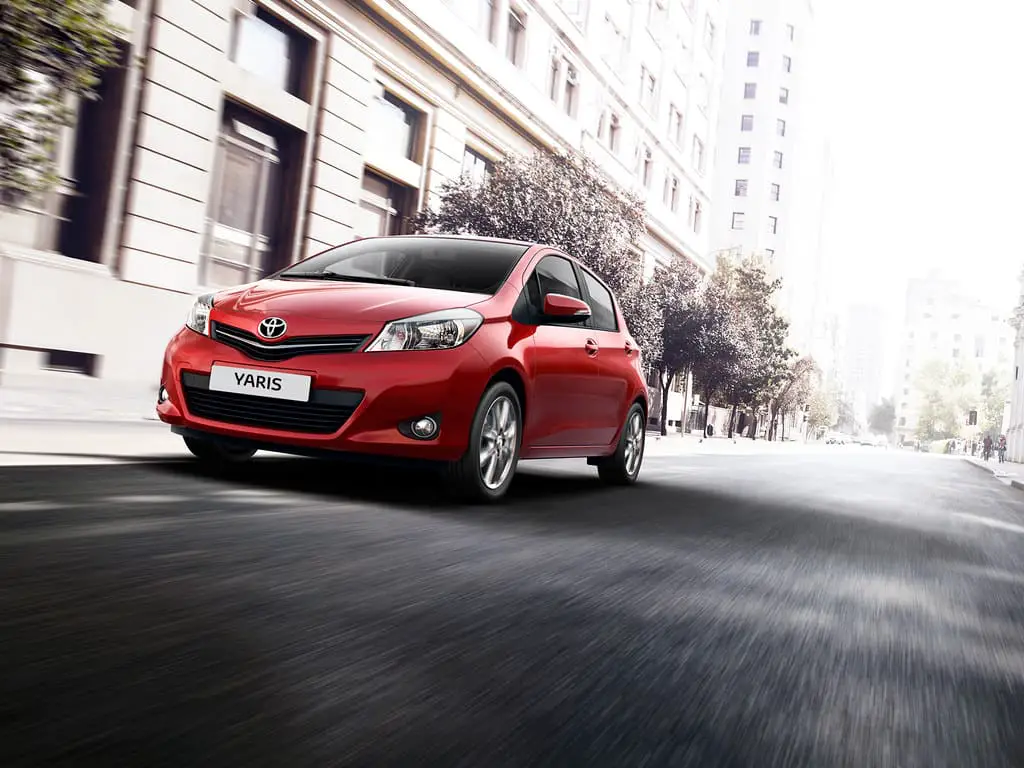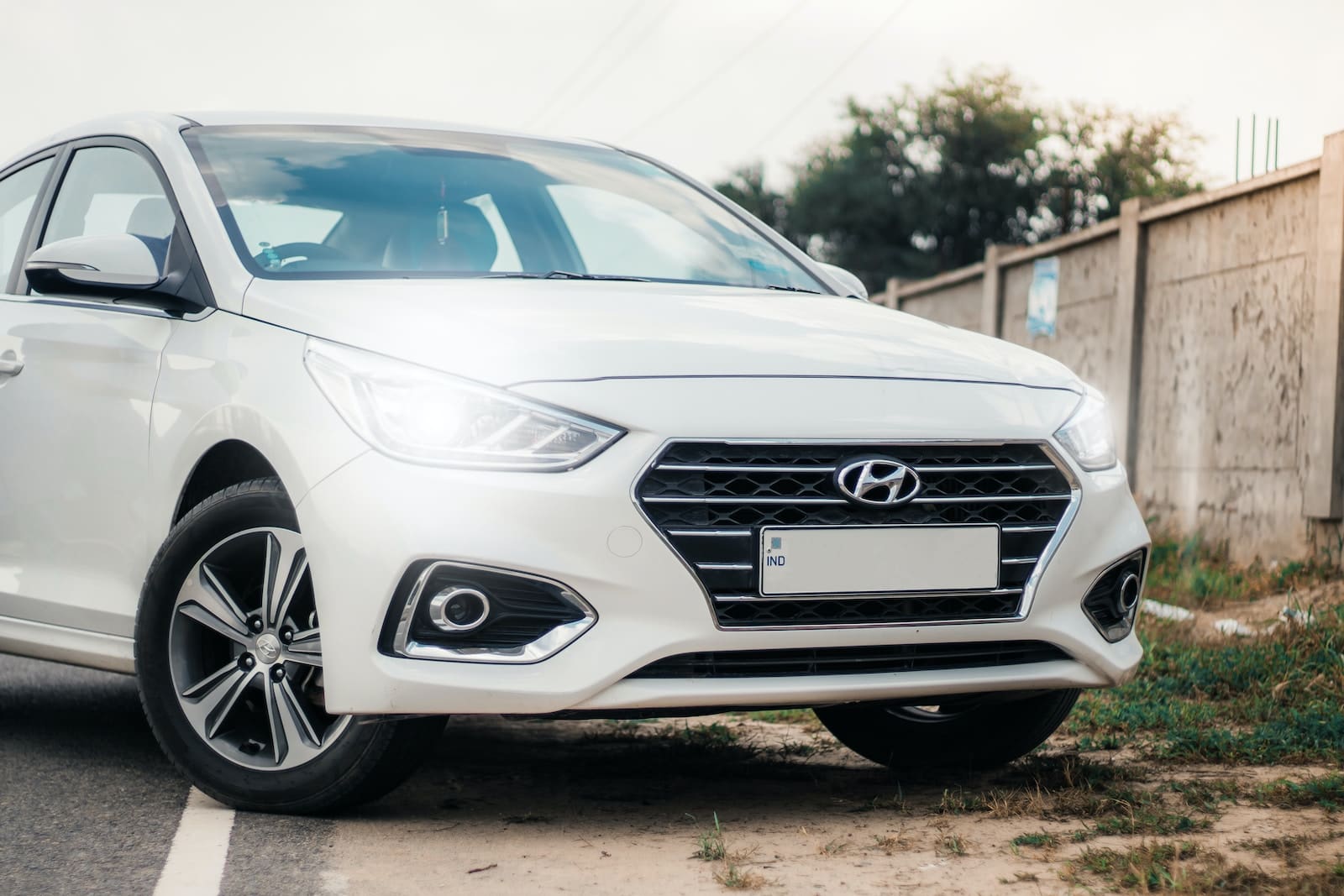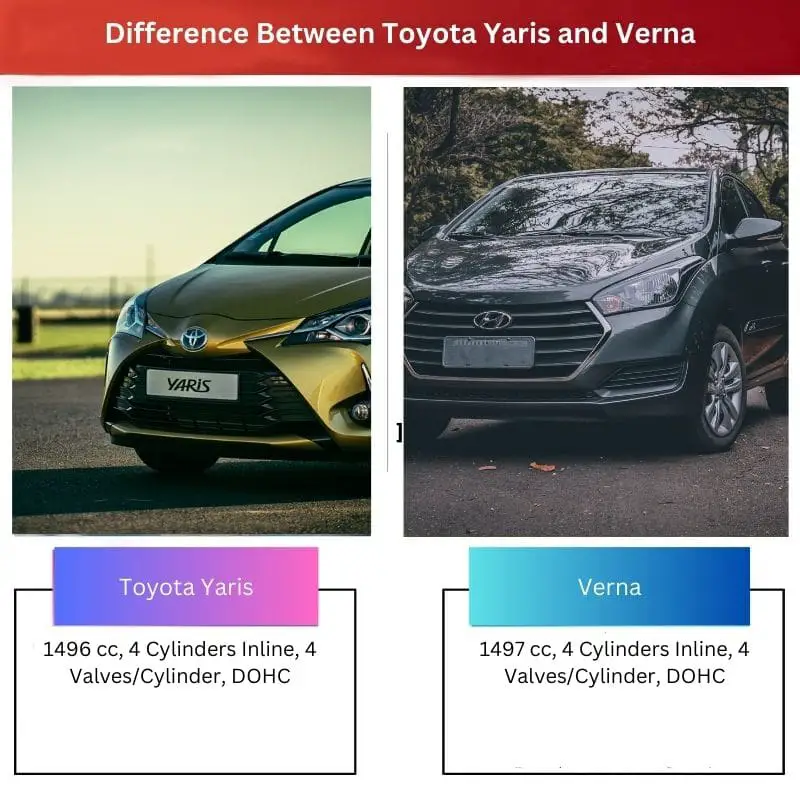While the Toyota Yaris is only available with a 1.5-litre petrol engine, the 2020 Verna facelift will include a 1.5-litre naturally aspirated petrol engine, a 1.5-litre oil burner, and a 1.0-litre turbo petrol engine.
While the current-generation Hyundai Verna has stayed at the top of the class’s sales rankings, Toyota entered the market late with the Yaris and has never entirely caught up.
However, Toyota has upgraded the C-segment sedan regularly throughout its history, and the Yaris benefits from Toyota’s brand value.
Key Takeaways
- Toyota Yaris has a smaller engine than Verna.
- Verna has a higher fuel efficiency than Toyota Yaris.
- Toyota Yaris has a more affordable starting price than Verna.
Toyota Yaris vs Verna
Toyota Yaris is a subcompact car. It is designed to be a practical and economical car that is ideal for urban driving. It has a sleek and modern exterior design. Verna is a car with sleek and sporty exterior design. It has features like LED headlights and taillights, alloy wheels, and a sunroof.

Yaris, Toyota’s entry-level vehicle, is a joint Mazda-Toyota production marketed in North America as the Mazda2 in Canada, Mexico, and Puerto Rico. In terms of body types, buyers may choose between a 4-door sedan and a 5-door hatchback for the 2020 Toyota Yaris.
The manual-transmission sedan starts at $16,580, including the $930 destination fee, for the basic L model.
For an extra $1,100, you can have an automatic gearbox.
Starting at $18,680, hatchbacks come standard with an automatic gearbox and the LE trim level.
In India, the Hyundai Verna has received yet another upgrade.
The petrol and diesel engines of this 2020 Hyundai Verna are now BS6 compliant.
The 1.5-litre gasoline engine makes 113 horsepower and 144 pound-feet of torque, while the 1.0-litre turbocharged gasoline engine produces 118 pound-feet of torque.
The Hyundai Verna’s dashboard and infotainment system have contours to emphasise its fluidic sculpture design concept.
The car’s rear interior also has meticulously carved lines to highlight its beauty.
Comparison Table
| Parameters Of Comparison | Toyota Yaris | Verna |
|---|---|---|
| Engine | 1496 cc, 4 Cylinders Inline, 4 Valves/Cylinder, DOHC | 1497 cc, 4 Cylinders Inline, 4 Valves/Cylinder, DOHC |
| Engine Type | 1.5L Dual VVT-i Engine | 1.5 l MPi |
| Power | 106 bhp @ 6000 rpm | 113 bhp @ 6300 rpm |
| Safety | 3 Airbags | 2 Airbags |
| Locking | Keyless | Remote with Boot Opener |
What is Toyota Yaris?
Over the years, the Toyota Yaris has remained primarily unchanged.
Other subcompacts have grown more enjoyable and rewarding.
While the vehicle’s total fuel efficiency of 32 mpg helps keep expenses down, that’s about it for the good news.
The vehicle’s four-speed automatic gearbox contributes to its sluggish acceleration.
Despite its compact size, parking is a challenge due to its slow handling and excessive body lean.
Sudden changes in pitch jar the ride, and the interior is filled with engine and traffic noise.
The absence of a telescopic steering wheel necessitates driving with your arms extended, and there is just a tiny amount of room for your left foot.
Rear passengers have enough space, but the bare-bones front seats are unpleasant for two people.
Adaptive cruise control with lane keep assist was included in 2017 vehicles.
Yaris will only be offered as a sedan in 2019; the Yaris iA was the only hatchback available before.
In 2020, the subcompact hatchback will make a comeback.
The Yaris is Toyota’s most affordable subcompact vehicle, and it’s reliable and cheap.
The sedan’s total fuel efficiency was 32 mpg with the automatic gearbox, while the hatchbacks were 30 mpg. The good news, on the other hand, does not go on much longer.
You’re forced to drive with your arms outstretched and your knees bowed because of an uncomfortable driving posture. Cheap materials and an inconvenient centre-mounted gauge cluster contribute to the overall feeling of squalor.
While acceleration is sufficient, the engine drone is noticeable, resulting in a harsh ride for all passengers.
Even if the ride and handling aren’t great, they’re better than most competitors.
Stability control, which became standard in 2010, makes emergency manoeuvring much safer, although older versions without it might be a real problem.

What is Verna?
Hyundai’s Verna has struggled the past two years due to consumer dissatisfaction.
Compared to Honda City and Maruti Suzuki Ciaz, it has barely sold a tenth as many units.
And Verna’s market share is only 4% of the whole category.
The new Verna’s debut in India is thus only around the corner.
The whole market is in desperate need of a disruptor.
The important lesson here is that a vehicle manufacturer must provide buyers with considerable car experience to succeed in this market.
More outstanding features, more storage, and more power result from this.
Hyundai’s solution is to make the Verna seem like an Elantra sister that’s just a little smaller.
This is the fifth generation of the Hyundai Verna, and it receives a whole new platform, which is internally referred to as the new ‘K2’ platform.
The platform is stiffer by nature. Therefore, high-strength steel is used more (50 percent of it in the new Verna).
With the platform in place, the car will have greater structural integrity and overall safety.
Design-wise, the new model follows the Fluidic 2.0 Design language we’ve grown to know and love.
The new Verna borrows from the Elantra in specific ways but retains the styling cues from the previous model’s design language.
While the Elantra-inspired curved headlights and distinctive LED tail lamps are on the Verna, they’ve been reworked for the new model.
The prominent characteristic chrome slatted bonnet grille also follows the Cascade design.
Even the boot-lid lip of the Verna is a rip-off of the Elantra’s design.
In addition, the new Verna is more significant; however, the precise dimensions of the India-spec vehicle have not yet been disclosed.
Everything else about the measurements worked for us except the roof, which is a little too snug at the back end.
Because of the tight curvature of the roofline, six-footers will have a hard time getting comfortable.

Main Differences Between Toyota Yaris and Verna
- The Toyota Yaris measures 4,425 mm in length, 1,730 mm in width, and 1,495 mm in height and has a 2,550 mm wheelbase. In contrast, the 2020 Hyundai Verna facelift measures 4,440 mm in length, 1,729 mm in width, 1,475 mm in height, and 2,600 mm in wheelbase.
- The Toyota Yaris is fueled by a solitary 1.5-litre four-chamber petroleum motor that produces 107 PS and 140 Nm of pinnacle force. Then again, Hyundai offers the Verna facelift with three powertrain choices: a 1.5-litre NA petroleum motor evaluated at 115 PS/144 Nm, a 1.5-litre diesel motor appraised at 115 PS and 250 Nm, and a 1.0-litre turbocharged petroleum motor evaluated at 120 PS and 172 Nm.
- The Toyota Yaris accompany highlights including a touchscreen infotainment framework with a cell phone network, voyage control, paddle shifters, and press button start/stop. At the same time, it moreover gets surrounding mindset lighting, a force-flexible driver’s seat, and rooftop-mounted back AC vents. However, Verna comes furnished with an 8-inch touchscreen infotainment framework with Apple CarPlay and Android Auto.
- The Toyota Yaris gets seven airbags, ABS with EBD, Brake Assist, front and back leaving sensors, backplate brakes, TPMS, Hill-start Assist Control, and Vehicle Stability Control, and that’s just the beginning. Conversely, the Verna accompanies six airbags, a tire pressure checking framework, front and back leaving sensors, ABS with EBD, crisis stop signal, Vehicle Stability Management, Hill-start Assist Control, Electronic Stability Control, back circle brakes, and so on.
- Toyota has priced the petrol-only Yaris at Rs 8.76 lakh and Rs 14.18 lakh. Verna’s diesel versions are priced between Rs 10.65 lakh and Rs 15.09 lakh (all prices, ex-showroom).





